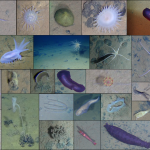When a sailor misses a chance to go to sea, he tends to wander around his garden, paying special attention to the clouds and the weather, as if he were walking on the ship’s deck in fresh sea air. He circles his home like it were a shipyard, looking for repairs. Today I noticed some rotting wood on the gable in a corner of the garden. A bee crawled out.
The adjacent firebush (Fig. 1) buzzes every morning with dozens of bees of a few different species. Two species are bumblebees, big, black, and loud; the other is small, like a honeybee, yellow and black. Hummingbirds also frequent the bush. I like it because it reminds me of a deep-sea coral colony, covered with invertebrates.
I am concerned about the bees because populations are in great decline throughout North America. So I take special care of this firebush, hoping to make a small contribution to their eventual recovery.

Unfortunately, fireflies are now also in jeopardy. Sailors love fireflies, naturally. It reminds us of bioluminescent flashes in the night sea. When I ask my neighbors, they say the same about South Texas, there don’t seem to be as many lightning bugs as their used to be. The problem, according to the news story, is a shortage of rotting wood. My bees live in rotting wood (Fig. 2) in the corner of my garage. Which I must repair, because I am not at sea when I should be. So I am met with a dilemma.

After scant consideration, I performed a rather dangerous and risky maneuver. The bees were preoccupied, and I was barefoot with a hammer looking for something to do. So I performed a rotting wood transplant. The technique maintains the wood’s character, height, and orientation (Fig. 3). Basically, the piece was (gingerly) removed from the garage and nailed to the fence.

I think its going to be a money maker. I am calling it “ornamental rotting wood”. The bees love it. No sooner than the last nail was pounded, two came scouting their new home. Isn’t that wonderful? A sailor saved a bumblebee today. You can, too. Keep your eyes open for rotting wood in your hood. Don’t throw it away. Make it “ornamental”.
Now, if I could only find a rotting plank full of lightning bugs….






Hi, Peter!
Good work for saving the bees! Yours are probably large carpenter bees. They look a lot like bumble bees, but their abdomens are less hairy and much more shiny. We see a lot of them nectaring in our butterfly bush, alongside other bees and various other collectors of nectar and pollen.
There are lots of great photos of carpenter bees in Wikipedia and at BugGuide.Net:
http://en.wikipedia.org/wiki/Carpenter_bee
http://bugguide.net/node/view/262
Thanks, Julie. None of those look exactly like these, but there appear to be two kinds of carpenters in the garden. One is all black. It bores a hole (?) in old firebush branches. My daughter made the mistake of bringing a stick inside (we caught and returned them). The other carpenter bee is yellow striped, living in the plank.
it’s funny, I grew up on the gulf coast and hurricanes don’t worry me. Tornados terrify me. I guess it’s what you know how to handle.
oops, that last comment was meant for another post. Re: bees, I think CCD is strictly a honeybee problem. The native bees are mostly OK.
Also, I don’t know much about carpenter bees, but I’d worry about them going through the old wood and into the fence. Termites would. The bees might stick to the rotting stuff.
The cross beams and posts are pressure treated (with arsenic, I’ve been told) and the facing is cedar. I wonder how pressure treated wood tastes to a bee. Can’t be good. But I’ll keep an eye on that. Thanks, Marmaduke.
There are all kinds of bees and wasps that nest in natural cavities, as well as some that bore their own. I’ve seen a little leafcutter bee (Megachilidae) nesting in a hollow plastic tube that had been used to make a perch on a backyard bird feeder! I also spent a few summers rearing solitary vespids (Eumeninae) from artificial trap nests.
I’ve seen some great demonstration nests in insect exhibits; the Arizona-Sonora Desert Museum outside Tucson has a great set of them, where you can watch bees and wasps hard at work provisioning (and in some cases usurping) nests. You can make one simply by drilling multiple holes in a block of wood and hanging it outside. If you make holes with a variety of sizes, you might even attract multiple species.
maybe some of your bees are mason bees? They live in holes in wood (I don’t think they make them though).
I understand too well the effects of your Sailing Deprivation Disorder. I’m very rarely at sea any more, thus I’m always walking around the house and yard looking for things that can be made fast, coiled (then coiled again, and then again), painted with antifoulant, and/or swabbed. I now completely understand too that sad pacing behavior I often see bears do in zoos.
A lovely post – you’re a regular Charles Darwin do you know that?
Thanks Karen. That’s so nice. We’ll see if you say that after you watch, … Italian Spiderman!!
Peter, put down the coffee cup and walk away.
Thanks for saving the bees! We have a dog that loves to eat honeybees. I try to keep her in when I see bees on the clover in our yard, but I have seen her chasing and eating them when she is out there. It breaks my heart, and I keep thinking how sad it is that another bee is disappearing.
S.O.B. (Save Our Bees!) Down in New Zealand our honeybees have been decimated by the veroa bee mite that has wiped out hives all over the North Island and has now crossed the strait to the S.I. I haven’t seen a bee in the garden or on the clover in the lawn now for over two years… :-(